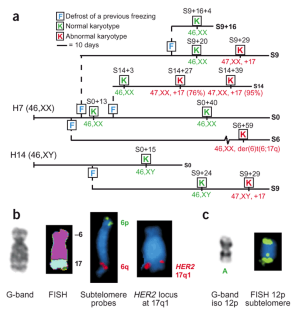Recurrent gain of chromosomes 17q and 12 in cultured human embryonic stem cells (original) (raw)
- Brief Communication
- Published: 07 December 2003
- Kath Smith2 na1,
- Paul Gokhale1,
- Harry D Moore3,
- Edna Maltby2,
- Julie Johnson4,
- Lorraine Meisner4,
- Thomas P Zwaka5,
- James A Thomson5 &
- …
- Peter W Andrews1
Nature Biotechnology volume 22, pages 53–54 (2004)Cite this article
- 5961 Accesses
- 10 Altmetric
- Metrics details
Abstract
We have observed karyotypic changes involving the gain of chromosome 17q in three independent human embryonic stem (hES) cell lines on five independent occasions. A gain of chromosome 12 was seen occasionally. This implies that increased dosage of chromosome 17q and 12 gene(s) provides a selective advantage for the propagation of undifferentiated hES cells. These observations are instructive for the future application of hES cells in transplantation therapies in which the use of aneuploid cells could be detrimental.
This is a preview of subscription content, access via your institution
Access options
Subscribe to this journal
Receive 12 print issues and online access
$209.00 per year
only $17.42 per issue
Buy this article
- Purchase on SpringerLink
- Instant access to full article PDF
Prices may be subject to local taxes which are calculated during checkout
Additional access options:
Figure 1: Karyotypic changes affecting chromosomes 17 and 12 in sublines of H7 hES cells.

Similar content being viewed by others
References
- Amit, M. et al. Dev. Biol. 227, 271–278 (2000).
Article CAS Google Scholar - Reubinoff, B.E., Pera, M.F., Fong, C.Y., Trounson, A. & Bongso, A. Nat. Biotechnol. 18, 399–404 (2000).
Article CAS Google Scholar - Thomson, J.A. et al. Science 282, 1145–1147 (1998).
Article CAS Google Scholar - Draper, J.S., Pigott, C., Thomson, J.A. & Andrews, P.W. J. Anat. 200, 249–258 (2002).
Article CAS Google Scholar - Atkin, N.B. & Baker, M.C. Lancet 2, 1349 (1982).
Article CAS Google Scholar - Rodriguez, E. et al. Genes Chromosomes Cancer 8, 230–236 (1993).
Article CAS Google Scholar - Skotheim, R.I. et al. Cancer Res. 62, 2359–2364 (2002).
CAS PubMed Google Scholar - Longo, L., Bygrave, A., Grosveld, F.G. & Pandolfi, P.P. Transgenic Res. 6, 321–328 (1997).
Article CAS Google Scholar - Henderson, J.K. et al. Stem Cells 20, 329–337 (2002).
Article CAS Google Scholar - Westermann, F. & Schwab, M. Cancer Lett. 184, 127–147 (2002).
Article CAS Google Scholar - Chiou, S.K., Jones, M.K. & Tarnawski, A.S. Med. Sci. Monit. 9, PI25–29 (2003).
CAS PubMed Google Scholar - Burdon, T., Smith, A. & Savatier, P. Trends Cell Biol. 12, 432–438 (2002).
Article CAS Google Scholar - Chambers, I. et al. Cell 113, 643–655 (2003).
Article CAS Google Scholar - Mostert, M.C. et al. Oncogene 16, 2617–2627 (1998).
Article CAS Google Scholar - Liu, X. et al. Dev. Dyn. 209, 85–91 (1997).
Article CAS Google Scholar
Acknowledgements
This work was supported in part by grants from the Biotechnology and Biological Sciences Research Council, Wellcome Trust and Yorkshire Cancer Research. We thank Henry Yuen and the Oskar Rennebohm Foundation for their gifts to the University of Wisconsin Foundation that helped support this work.
Author information
Author notes
- Jonathan S Draper and Kath Smith: These authors contributed equally to this work.
Authors and Affiliations
- Department of Biomedical Science, University of Sheffield, Western Bank, Sheffield, S10 2TN, UK
Jonathan S Draper, Paul Gokhale & Peter W Andrews - North Trent Clinical Cytogenetics Service, Sheffield Children's Trust, Western Bank, Sheffield, S10 2TH, UK
Kath Smith & Edna Maltby - Section of Reproductive and Developmental Medicine, University of Sheffield, Royal Hallamshire Hospital, Jessop Wing, Sheffield, S10 2SF, UK
Harry D Moore - Cytogenetic Laboratory at Wisconsin State Laboratory of Hygiene, 465 Henry Mall, Madison, 53706, Wisconsin, USA
Julie Johnson & Lorraine Meisner - National Primate Research Center and the Department of Anatomy, University of Wisconsin–Madison Medical School, 1200 Capital Court, Madison, 53715, Wisconsin, USA
Thomas P Zwaka & James A Thomson
Authors
- Jonathan S Draper
You can also search for this author inPubMed Google Scholar - Kath Smith
You can also search for this author inPubMed Google Scholar - Paul Gokhale
You can also search for this author inPubMed Google Scholar - Harry D Moore
You can also search for this author inPubMed Google Scholar - Edna Maltby
You can also search for this author inPubMed Google Scholar - Julie Johnson
You can also search for this author inPubMed Google Scholar - Lorraine Meisner
You can also search for this author inPubMed Google Scholar - Thomas P Zwaka
You can also search for this author inPubMed Google Scholar - James A Thomson
You can also search for this author inPubMed Google Scholar - Peter W Andrews
You can also search for this author inPubMed Google Scholar
Corresponding author
Correspondence toPeter W Andrews.
Ethics declarations
Competing interests
P.W.A. and J.S.D. have equity in Axordia, Ltd., a university spinout company dedicated to development of stem cell technology.
Supplementary information
Rights and permissions
About this article
Cite this article
Draper, J., Smith, K., Gokhale, P. et al. Recurrent gain of chromosomes 17q and 12 in cultured human embryonic stem cells.Nat Biotechnol 22, 53–54 (2004). https://doi.org/10.1038/nbt922
- Received: 09 July 2003
- Accepted: 20 October 2003
- Published: 07 December 2003
- Issue Date: 01 January 2004
- DOI: https://doi.org/10.1038/nbt922